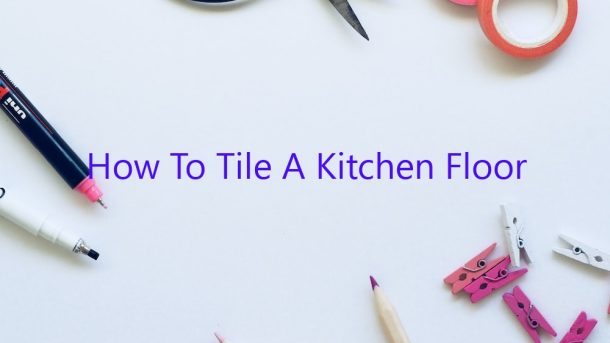Tile is a popular flooring choice because it is durable, easy to clean, and comes in a variety of colors and styles. If you are considering tiling your kitchen floor, here are some tips to help you get started.
First, determine the size and shape of your kitchen floor. You will need to measure the dimensions of the room and sketch out a plan of the layout. This will help you determine how many tiles you will need and what size and shape of tiles will work best.
Next, choose a tile type. There are many different types of tile available, including ceramic, porcelain, stone, and glass. Consider the color, style, and durability of each type before making a decision.
Once you have chosen a tile type, you will need to decide on a grout color. Grout is the material that is used to fill the spaces between tiles. Grout comes in a variety of colors, so you can choose one that will match or contrast with your tile.
Once you have selected your tile and grout, you will need to prepare the floor. This may involve removing the old flooring, leveling the surface, and installing a new subfloor if necessary.
Once the floor is ready, you can begin tiling. Begin in one corner of the room and work your way out, using a tile cutter to cut tiles to size as needed. Be sure to leave a space between the tiles and the walls to allow for grout.
After the tiles have been installed, let them dry for 24 hours. Then, apply grout to the spaces between the tiles using a grout float. Be sure to smooth out the grout and remove any excess grout. Let the grout dry for 24 hours before sealing it with a grout sealant.
That’s it! Your kitchen floor is now ready for use.
Contents
Can I tile kitchen floor myself?
Yes, you can tile your kitchen floor yourself, but it may be more difficult than you think. Kitchen floors are often wet and can be slippery, which can make the tiling process more difficult.
Before you start tiling, you’ll need to purchase some materials. You’ll need tile, mortar, a trowel, a tile saw (if you’re cutting tiles), and a sponge.
The first step is to measure the area you want to tile and purchase the appropriate amount of tile. Then, mix the mortar according to the instructions on the packaging.
Once the mortar is ready, start by applying it to the floor in a thin layer. Use the trowel to spread the mortar evenly over the surface. Then, place the tiles in the mortar, making sure they are pressed down firmly.
Once all of the tiles are in place, use the tile saw to cut any tiles that need to be cut. Be careful not to cut yourself!
Finally, allow the mortar to dry completely. Once it’s dry, you can apply a sealant to the tiles to protect them from water and dirt.
How do you prepare a kitchen floor for tile?
There are a few key things you need to do in order to prepare your kitchen floor for tile. The first step is to make sure the surface is smooth and level. If there are any bumps or lumps, you’ll need to fix them before you start tiling.
The next step is to make sure the floor is clean and free of debris. Use a broom or a vacuum cleaner to get rid of any dust or dirt. If there is any grease or oil on the floor, you’ll need to clean it up with a degreaser.
Once the floor is clean, you can start laying down the tiles. Start in one corner of the room and work your way out, making sure the tiles are firmly stuck to the floor. If you need to cut any tiles, use a sharp knife or a tile saw.
When you’re finished, leave the tiles to set for 24 hours. Once they’re set, you can grout the tiles and seal them with a sealant.
What do you put down before you tile a floor?
When you’re getting ready to tile a floor, there are a few things you need to do first. You’ll need to decide on the layout of the tiles, and you’ll also need to choose a adhesive and grout. In addition, you’ll need to prepare the surface of the floor before you start tiling.
The first step is to decide on the layout of the tiles. You can use a tile cutter to cut the tiles to the correct size, or you can buy tiles that are already the correct size. Once you have decided on the layout, you can start to prepare the surface of the floor.
If the floor is concrete, you’ll need to use a concrete primer to prepare it. If the floor is made of wood, you’ll need to use a wood primer to prepare it. Once the primer has dried, you can start to apply the adhesive.
You’ll need to spread the adhesive evenly over the surface of the floor. Then, you can start to place the tiles in the desired layout. Be sure to apply pressure to the tiles to ensure that they stick to the adhesive.
Once the tiles are in place, you can let them dry for 24 hours. Then, you can apply the grout. Be sure to use a grout saw to get the best results. You can also use a grout float to spread the grout over the tiles.
Let the grout dry for 24 hours, and then you can enjoy your new tile floor!
Where do you start when laying kitchen floor tiles?
When it comes to kitchen floor tiles, there are a few things you need to take into account before getting started. The first step is to determine the size and shape of the tiles, and then decide on the layout. Once you have a plan in place, you can start measuring and cutting the tiles.
The most important thing to keep in mind when choosing kitchen floor tiles is the type of traffic the room will see. If the kitchen is used frequently, you’ll need a durable tile that can withstand a lot of wear and tear. Porcelain and ceramic tiles are both good options, and they come in a variety of colors and styles.
Once you’ve chosen the tiles, it’s time to start measuring. Begin by measuring the length and width of the room, and then add an extra inch to each measurement. This will allow for the grout lines. Next, mark the center of the room and start measuring from there. For rectangular rooms, measure from one corner to the opposite corner. For square rooms, measure from one corner to the middle of the opposite side.
Once you have the measurements, it’s time to start cutting the tiles. Use a tile cutter to cut the tiles to size, or use a wet saw if you need to cut them on a curve. If you’re using a wet saw, be sure to follow the manufacturer’s instructions carefully.
Once the tiles are cut, it’s time to start laying them. Begin by laying out a few tiles in one corner to test the layout. If everything looks good, start laying the tiles in rows, making sure to stagger the joints. Use a level to ensure that the tiles are straight, and use spacers to create even gaps between the tiles.
When you reach the end of a row, cut the tile to size and then lay it in place. Be sure to use the same technique as you did in the beginning, staggering the joints and using spacers. When you reach the other end of the room, cut the last tile to size and lay it in place.
If you have any leftover tiles, you can save them for future projects. Just make sure to store them in a dry place, away from the sun and heat.
Can you lay tile and grout the same day?
Can you lay tile and grout the same day? This is a question that many homeowners ask when they are starting a renovation project. The answer is that it is possible to do, but there are a few things that you need to keep in mind.
The main thing to remember is that the tile and grout need to be compatible. If you are using a tile adhesive, make sure that it is designed to be used with grout. In addition, you need to make sure that the grout you are using is also compatible with the adhesive.
Another thing to keep in mind is that the tile and grout need to be dry before you can apply the grout. If the tile is still wet, the grout will not adhere to it properly. In addition, the grout will not be able to cure properly if it is applied over a wet surface.
It is also important to make sure that the surface is clean and free of debris before you start tiling. The adhesive will not adhere to the surface properly if it is dirty.
If you are planning to lay tile and grout the same day, it is a good idea to start with the smaller tiles. This will help to ensure that the grout is applied evenly.
If you are not comfortable doing it yourself, you can always hire a professional to do the job for you.
What is the most popular tile for kitchen floor?
What is the most popular tile for kitchen floor?
There are many factors to consider when choosing a tile for your kitchen floor. The most popular tile for kitchen flooring is ceramic, although vinyl and stone are also popular options.
Ceramic tiles are durable and easy to clean, making them a popular choice for kitchen flooring. They are available in a variety of colors and styles, making it easy to find a style that will suit your kitchen. Ceramic tiles are also relatively affordable, making them a budget-friendly option.
Vinyl tiles are also a popular choice for kitchen flooring. They are durable and easy to clean, and are available in a variety of colors and styles. Vinyl tiles are also affordable, making them a budget-friendly option.
Stone tiles are also a popular choice for kitchen flooring. They are durable and easy to clean, and are available in a variety of colors and styles. Stone tiles are also relatively expensive, making them a more expensive option.
Do you put grout under tile?
Do you put grout under tile? This is a question that many homeowners have, and the answer is it depends. In some cases, grout is not necessary under tile and can even cause problems. In other cases, grout is necessary for a proper installation.
One of the main purposes of grout is to provide a watertight seal between tiles. If you are installing tile on a floor, you will definitely need grout to fill the spaces between the tiles and to create a seal. However, if you are installing tile on a wall, you may not need grout.
Tile on a wall can be installed with a thin-set adhesive, which will create a watertight seal between the tile and the wall. Grout is not necessary in this case, and it can actually cause problems. Grout can trap moisture and cause tiles to loosen and fall off the wall.
If you are installing tile on a floor, grout is definitely necessary. The spaces between the tiles must be filled with grout in order to create a watertight seal. If you do not use grout, the tiles will eventually loosen and fall off the floor.
There are a few different types of grout available, so it is important to choose the right type for your installation. Epoxy grout is a good option for floors, because it is watertight and durable. Mortar grout is also a good option for floors, because it is durable and can withstand a lot of foot traffic. Cement grout is a good option for walls, because it is watertight and can withstand moisture.
In conclusion, the answer to the question “Do you put grout under tile?” depends on the type of tile installation. If you are installing tile on a wall, you may not need grout. If you are installing tile on a floor, grout is definitely necessary.




